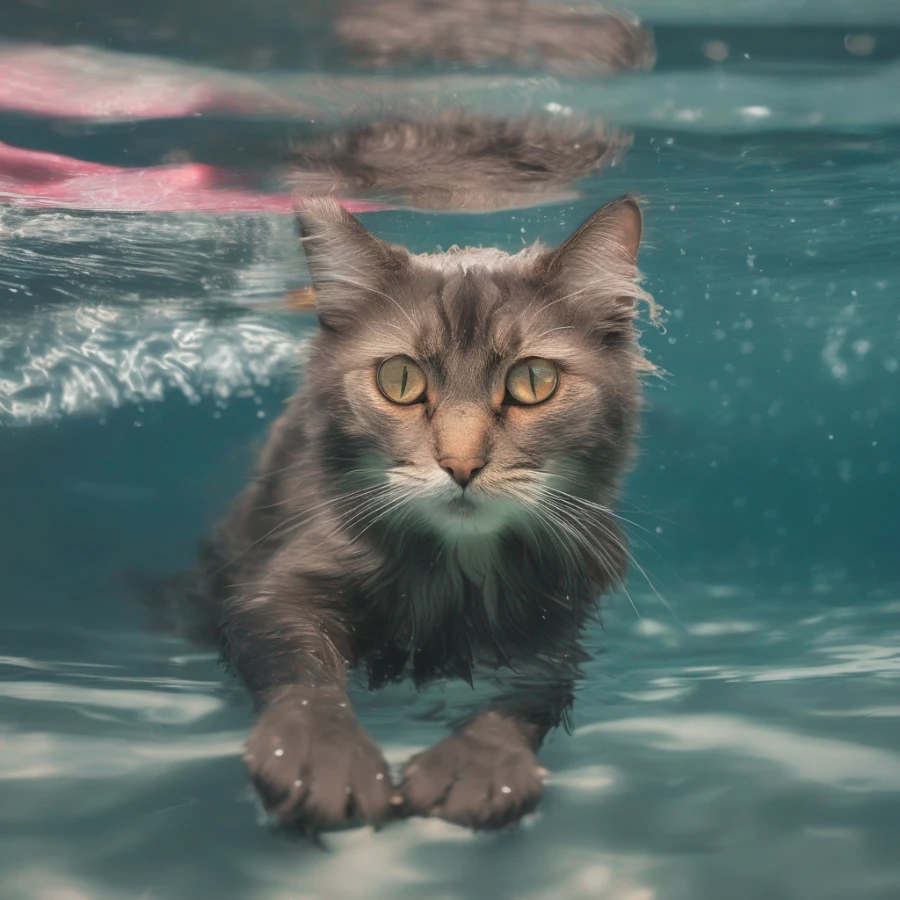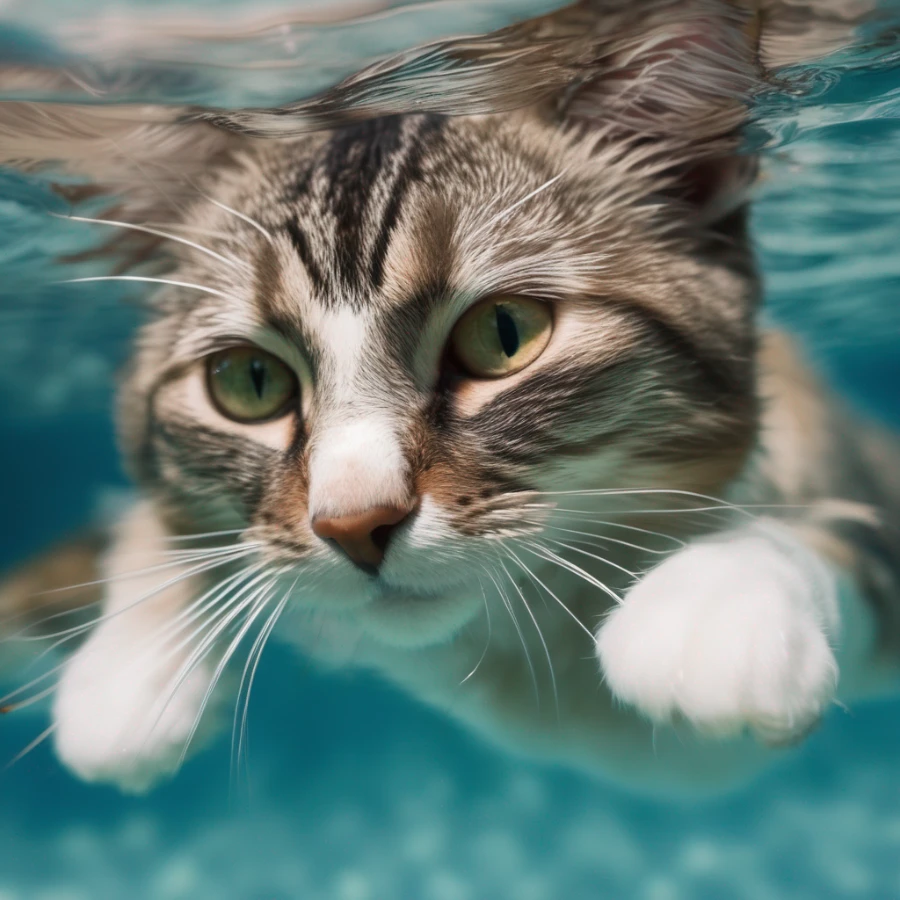Do Cats Really Know How to Swim

Published by: Tatsiana Korshik
Time to Read: 7 Min

While cats have a reputation for hating water, the reality is that their aversion doesn't reflect their swimming abilities. Unlike dogs, which often enjoy splashing in lakes and rivers, most cats are not enthusiastic about water activities. However, this behavior doesn't mean they can't swim.
The misconception that cats avoid water because they can't swim is common. In truth, a cat's reluctance to engage with water is more about their preferences than their abilities. Even if your cat vehemently resists bath time, it doesn't mean they are incapable of swimming. Swimming is actually a natural instinct for all felines, regardless of whether they have had the opportunity to practice.
So, while your cat may not be eager to dive into a pool or lake, rest assured that they have the innate ability to swim if the need arises. Their dislike for water is simply a matter of personal preference rather than a reflection of their swimming skills.
Wild cats, such as tigers, jaguars, and lions, demonstrate the swimming prowess of felines. Tigers, for example, can swim up to 9 miles at a time, using waterways to track prey and evade predators. Despite their domestication, house cats retain this innate ability to swim, especially when faced with life-threatening situations. Even kittens instinctively know how to stay afloat, albeit for a limited time due to their small size and strength.
However, it's important to note that instinctive swimming skills don't equate to being strong swimmers. While cats can stay above water for short periods, swimming long distances requires significant physical strength, dexterity, and mental resilience. As such, cats are still susceptible to drowning, particularly based on factors like age, health, and prior swimming experience.
Whether a cat enjoys swimming depends on various factors. While many cats have a strong aversion to water, not all do. This aversion may stem from an instinctual awareness of the drowning risk in large bodies of water, among other reasons.
Some reasons cats dislike water include:
The misconception that cats avoid water because they can't swim is common. In truth, a cat's reluctance to engage with water is more about their preferences than their abilities. Even if your cat vehemently resists bath time, it doesn't mean they are incapable of swimming. Swimming is actually a natural instinct for all felines, regardless of whether they have had the opportunity to practice.
So, while your cat may not be eager to dive into a pool or lake, rest assured that they have the innate ability to swim if the need arises. Their dislike for water is simply a matter of personal preference rather than a reflection of their swimming skills.
Do Cats Know How to Swim?
Cats have been domesticated for over 10,000 years, but their ancestors were adept at surviving in the wild. They knew how to hunt, stay warm, avoid predators, and navigate dangerous situations, including swimming. While early cats from desert regions may not have needed to swim frequently, they evolved to instinctively paddle and keep their heads above water.Wild cats, such as tigers, jaguars, and lions, demonstrate the swimming prowess of felines. Tigers, for example, can swim up to 9 miles at a time, using waterways to track prey and evade predators. Despite their domestication, house cats retain this innate ability to swim, especially when faced with life-threatening situations. Even kittens instinctively know how to stay afloat, albeit for a limited time due to their small size and strength.
However, it's important to note that instinctive swimming skills don't equate to being strong swimmers. While cats can stay above water for short periods, swimming long distances requires significant physical strength, dexterity, and mental resilience. As such, cats are still susceptible to drowning, particularly based on factors like age, health, and prior swimming experience.
Do Cats Enjoy Swimming?
Ancient cats and modern-day big cats utilize their swimming abilities for both hunting and leisure. Observers have witnessed tigers playing in water with the exuberance of children in a public pool. However, most house cats only swim when necessary.Whether a cat enjoys swimming depends on various factors. While many cats have a strong aversion to water, not all do. This aversion may stem from an instinctual awareness of the drowning risk in large bodies of water, among other reasons.
Some reasons cats dislike water include:
- Heavy, limiting mobility
- Long, thick fur that takes a long time to dry
- Discomfort with cold temperatures
- The physical strength and energy required for swimming
- Negative past experiences
Any one of these reasons can lead a cat to prefer keeping their paws dry, avoiding water in all but the most necessary circumstances
Why Do Cats Hate Water?

While your cat may know how to swim, it's possible that swimming is not their favorite activity. The reasons why many cats dislike water are not entirely clear, but there are several theories.
According to Fischer, 'It could be due to a number of reasons, such as a negative experience with water, like a forced bath as a kitten or falling into the pool. Another theory is that cats evolved from desert climates and didn’t have a lot of exposure to rivers, lakes, etc. Or perhaps it is due to them just not liking having a drenched and heavy coat!
However, not all domestic cats share this aversion to water. Fischer notes, 'In fact, some breeds of cats love the water, such as Maine Coon, Bengal, and Manx breeds.
When Cats Love Water
Some cat breeds, such as the Bengal, Turkish Van, Abyssinian, and Maine Coon, are renowned for their affinity for water. These cats often eagerly anticipate bath time and relish outdoor adventures near water, such as swimming holes or boat trips. Additionally, mixed breed cats can also exhibit a love for water, showcasing the diversity of feline behavior.Water-loving cats enjoy both splashing and swimming. While some are strong and graceful swimmers, capable of covering impressive distances, most cats swim at a leisurely pace. They paddle to keep themselves moving but are not typically interested in swimming quickly. As a result, determining the speed at which an adult cat can swim is challenging.
Introducing Cats to Water
If you envision family lake vacations with your cat calmly sitting on your kayak, it's essential to introduce your cat to water well before your trip. By providing plenty of time and gentle practice, you increase the likelihood of your cat developing a positive relationship with water. Avoid forcing your cat into situations they're uncomfortable with, such as the kiddie pool or bathtub, as this can be traumatizing. Instead, use treats, praise, and toys to encourage them to explore the water at their own pace. With patience and encouragement, you can help your cat develop a love for water, especially when starting at a young age.Even if your cat is a proficient swimmer, it's not always advisable to bring them on water adventures. If they're not entirely comfortable, they may panic and put everyone at risk. Before setting sail, ensure your cat is comfortable and willing to participate in your plans.
Can you train your cat to like the water
If you want to encourage your cat to enjoy water, it's crucial never to force them into activities they're not comfortable with.Instead, introduce water gradually and use positive reinforcement to create positive associations. According to Fischer, 'If you are trying to train your cat to enjoy swimming or playing in the water, make sure to do so slowly. Give them opportunities to enjoy it themselves and offer lots of positive reinforcement, such as extra pets and treats, when they willingly give it a try.


